Great Storytellers for Children: Rabindranath Tagore
Tagore believed that childhood was a phase of life that embodied the finest ideals in human existence and this is reflected in his writing. The tenderness of the mother-child relationship is another pervasive theme.

(This is the first in a series on iconic authors who wrote for children.)
By Deepa Agarwal
“Kabuliwala” is a story that touched my heart deeply as a child. This classic tale by Rabindranath Tagore, originally written in Bengali, continues to reach out to young readers with its timeless appeal, as do his other works for children.
Tagore was one of the most outstanding and influential literary figures in our country. He launched new literary trends in Bengal and was the first non-European to receive the Nobel Prize in 1913. He also has the distinction of writing our national anthem “Jana Gana Mana” as well as that of Bangladesh “Amar Shonar Bangla”. What is most remarkable, however, he was one of the major Indian writers to recognise the importance of creating high quality literature for children. In fact, he acknowledged childhood as one of his main sources of inspiration. Thus, a significant part of his immense body of work consists of poems, plays, short stories and a novel for young readers, and much of his other writing is accessible to them too.
Born to Debendranath Tagore and Sarada Debi in Kolkata in 1861, Rabindranath belonged to a family that was steeped in art, music and literature. It is said that he wrote his first poem at the age of eight.
Among his popular works are “Bristi Pare Tapur-Tupur” (The Rain Falls Pitter-Patter), an early poem that recreates the rhythm of the Bengali nursery rhymes that he loved in his childhood. “Saat Bhai Champa” (Seven Brothers Champa) is a fairy tale poem and both were published in the magazines Bharati and Balak.
Also Read| Short story for kids: The Rats’ Feast by Rabindranath Tagore
Kadi-o-Komal (Sharps and Flats; 1886) was his first collection of poetry for children, followed by Sonar Tari (Golden Boat; 1894) and Kshanika (The Flitting One; 1900). The celebrated Sisu (Child; 1903) is a collection that contains many poems, several written for his children after his wife’s death. Tagore translated some of these poems into English himself and Macmillan in London published a representative collection in 1913 titled The Crescent Moon. Gitimalya or Wreath of Songs was another that appeared in 1914.

Tagore believed that childhood was a phase of life that embodied the finest ideals in human existence and this is reflected in his writing. The tenderness of the mother-child relationship is another pervasive theme. The poet lost his own mother at an early age. Tragically his wife passed away too at the young age of twenty-nine and he had to fill the role of a mother to his bereaved children. A large number of his children’s poems were written at that time, in an attempt to cope with his loss and divert and instruct his children as well. In many of these verses, the mother-child bond almost acquires an aura of sanctity like in the poem “Clouds and Waves”. In poems like “Fairyland” this attachment is charmingly depicted as the trust that leads the child to share his secret inner world with his mother. A similar mood of fantasy, though more playful, runs through “Birpurus” (The Hero) another very popular poem where the child goes off on an imaginary journey during which he protects his mother from all kinds of dangers. Mother-love is perceived as an inspirational power here, motivating the child to perform heroic deeds.
Tagore’s prose works also expound many of the themes that abound in his poetry but in a more directly didactic manner. In his novel Rajarshi (The Sacrifice) blood sacrifice becomes a metaphor for needless violence and the narrowness of religious fanaticism. Kabuliwala (1893), which I mentioned earlier,demonstrates a child’s natural, artless response to other human beings, regardless of race or creed. The young girl Mini is one of those archetypal children in Tagore’s work, who assist their elders in uncovering essential truths.

Tagore believed staunchly in the benefits of the simple and natural as opposed to the materialistic life. Thus, the short story “Guptadhan”(Hidden Treasure: 1905) illustrates the perils of material attachment as does the fable “The New Queen’s Heart’s Desire”. Other stories like Ichhapuran (Wish Fulfilment: 1896) a humorous fantasy, explore topics like contentment with your lot. His play Mukut (The Crown: 1885), depicts the evils of ambition, when the rivalry between two princes ends in the tragic death of the selfless oldest brother.
In the satirical “The Tale of a Parrot” the caged bird who previously ranged free becomes a metaphor for an educational system where knowledge is forced down children’s throats without paying any heed to their actual needs. One of his most admired plays, Dakghar (Post Office: 1911) is a poignant story about a sick boy Amal confined because of the doctor’s ignorance. He is, however, able to transform the ordinary by the force of his imagination.
Other stories like Khokha Babur Pratyabartan (The Return of Khokhababu) “The Homecoming” Atithi (Guest) Chuti (Leave) and Ramakanier Nirnbuddhita (Ramkanai’s Foolishness) also display his concern that children should grow and develop in natural surroundings and education should be a means of opening up their minds.
This concern found culmination in the founding of Shantiniketan in 1901, when he set up a school where children learnt their lessons in the open air, and expressed their creativity through the mediums of art, dance and music. To carry his theory of education further, Tagore even edited a series of children’s primers; Sahaj Path (Easy lessons, Calcutta, 1930) which were illustrated by one of the best-known artists of the Bengal school, Nandlal Bose.
Gurudev Rabindranath Tagore wrote many more poems and stories inspired by his vision of childhood. He also drew upon myths and fairy tales to expound his philosophy of life. To this day, his work continues to inspire and has been effectively interpreted in different mediums like music, art, theatre and cinema.
Also Read| Rabindranath Tagore on teaching without textbooks
(Author, poet and translator, Deepa Agarwal writes for both children and adults and has over 50 books to her credit. She interacts regularly with children, conducting creative writing workshops and storytelling sessions in schools.)
Source: Read Full Article
